WERE THE ARABS INDIGENOUS TO MANDATORY PALESTINE?
by Sheree Roth
The Rape of Palestine, 1st ed. By William Ziff. London: Longmans, Green and Co., 1938. Reprint. Mansfield Centre, Conn.: Martino Fine Books, 2010. 630 pp. $60.
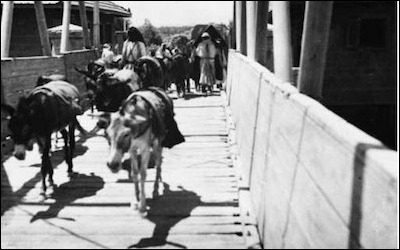
A train of donkeys and Arabs crosses from Transjordan into Palestine on a bridge over the Jordan River, July 3, 1936. The assertion that Palestinian Arabs are the indigenous population is central in their dispute with Israel. But waves of immigration from other Arab countries brought many to the territory. In 1936, a French high commissioner for Syria asserted that Arabs were moving from Damascus to Palestine because of the prosperity there.
The assertion that Palestinian Arabs are the indigenous population is central in their dispute with Israel. The message is that Jews stole and now occupy the land of the indigenous Arab population. Rarely challenged, the claim is widespread, such as this statement from Henry Cattan, a Palestinian Christian jurist and writer born in Jerusalem:
The Palestinians are the original and continuous inhabitants of Palestine from time immemorial.[1]
Palestinian Authority (PA) president Mahmoud Abbas elaborated this claim in a recent speech:
Our narrative says that we were in this land since before Abraham. I am not saying it. The Bible says it. The Bible says, in these words, that the Palestinians existed before Abraham. So why don't you recognize my right?[2]
Saeb Erekat, the PA's chief negotiator, stated:
I am the son of Jericho. ... the proud son of the Netufians and the Canaanites. I've been there for 5,500 years before Joshua Bin Nun came and burned my hometown Jericho.[3]
To be sure, some Arabs are descendants of the indigenous occupants. But waves of immigration into the Holy Land brought Jews, Arabs, and others to the territories, to the point that most of today's Arabic-speakers do not trace their roots back for centuries.
A number of analyses address the subject of Arab immigration to Palestine: Joan Peters' From Time Immemorial,[4] Arieh Avneri's The Claim of Dispossession,[5] and Fred M. Gottheil's essay, "The Smoking Gun: Arab Immigration into Palestine, 1922-1931."[6] But, William B. Ziff's little remembered The Rape of Palestine, published in 1938, adds an important first-hand source to these recent studies. None of the modern authors used Ziff as a source, so this is new information to present-day analysts.
Ziff (1898-1953) was born in Chicago and co-founded the Ziff-Davis Publishing Company, which specialized in technical magazines in such subject areas as aviation, radio, and photography. Active in Zionist politics, his Rape of Palestine was considered by the British Foreign Office "a violent and offensive book," and for years afterward, the British monitored the Zionist writings and speeches of this "unscrupulous gangster," fearful that his audiences were "lapping this poison up."[7]
The thrust of Ziff's book is on British policy in Palestine during the mandate period, but what is especially interesting today are his comments on the migration of Arabs and the squelching of Jewish immigration by the British. The following extensive quotes show the value of his work.
"Indigenous" Pre-20th Century Foreigners
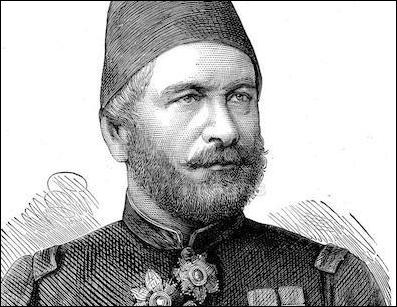
Ziff notes that foreigners already peopled the land:[8]
It was always the foreign soldier who was the police power in Palestine. The Tulunides brought in Turks and Negroes. The Fatamids introduced Berbers, Slavs, Greeks, Kurds, and mercenaries of all kinds. The Mamelukes imported legions of Georgians and Circassians. Each monarch for his personal safety relied on great levies of slave warriors. Saladin, hard-pressed by the Crusaders, received one hundred and fifty thousand Persians who were given lands in Galilee and the Sidon district for their services.
Out of this human patch-work of Jews, Arabs, Armenians, Kalmucks, Persians, Crusaders, Tartars, Indians, Ethiopians, Egyptians, Sudanese, Turks, Mongols, Romans, Kharmazians, Greeks, pilgrims, wanderers, ne'er-do-wells and adventurers, invaders, slaves ... was formed that hodge-podge of blood and mentality we call today "Levantine." ...
In the fourteenth century, drought caused the immigration into Palestine of eighteen thousand "tents" of Yurate Tartars from the Euphrates. Soon followed twenty thousand Ashiri under Gaza, and four thousand Mongols under Moulai, who occupied the Jordan Valley and settled from Jerusalem south. Kaisaite and Yemenite tribes followed in their trail. ...
In 1830 the Albanian conqueror Mehemet [Muhammad] Ali colonized Jaffa, Nablus, and Beisan with Egyptian soldiers and their Sudanese allies. Fourteen years later, Lynch estimated the thirteen thousand inhabitants of Jaffa to be composed of eight thousand Turco-Egyptians, four thousand Greeks and Armenians, and one thousand Jews and Maronites. He did not consider that there were any Arabs at all in that city.[9]
Ziff continues:
One hundred years ago, [Jaffa] had a population of four thousand. Today it holds seventy thousand, overwhelmingly Arab, who are largely descendants of the Egyptians and Ethiopians brought in by the conqueror Ibrahim Pasha [Muhammad Ali's son]. The few thousand Jews who lived here fled during the 1936 riots, abandoning their shops and property.[10]
Arabs Attracted to Jewish Settled Areas
Ziff reports that Jews invested large sums of money to "facilitate" Jewish immigration and encourage Jewish settlement in Palestine:
The amount of Jewish capital invested in this tiny land is estimated to total more than £120,000,000. Prior to the recent riots, Jews were bringing in money at the rate of two to five million dollars a month. In 1934 alone, they are estimated to have invested approximately £10,000,000 in Palestine. Today the productive output of the Jewish community is placed at £20,000,000 annually.[11]
All the authors mentioned above refer to the Arabs as being attracted by Jewish economic activity to their settled areas. Ziff describes this pattern:
Not until the Zionists had arrived in numbers did the Arab population begin to augment itself. The introduction of European standards of wage and life acted like a magnet on the entire Near East. Abruptly, Palestine became an Arab center of attraction. By 1922, after a quarter century of Jewish colonization, their numbers mushroomed to 488,000. Today they are over a million.
If the English contention were accurate, we should expect to find an exodus of Arabs from areas where Jews are settled into purely Arab regions. But exactly the opposite is true: It is precisely in the vicinity of these Jewish villages that Arab development is most marked. Arab Haifa, profiting by the Zionist boom, grew from 1922 to 1936 by 130%, Jaffa by 80%, and Jerusalem by 55%. The Arab rural settlement in the Tel Aviv district increased by over 135%. The all-Arab city of Nablus, which held 33,000 before the war, has fallen to less than 12,000. Safed which had 20,000, dropped to less than 9,000.[12]
Lack of Jobs for Jews
Ziff elaborates on Jewish efforts, both from within and from abroad, to create more jobs for those Jews emigrating to Palestine as well as those already living there. These efforts spurred significant economic growth and consequently accomplished the goal of providing employment. However, British policy resulted in a stream into Palestine of illegal Arab immigrants who filled these jobs in lieu of the barred Jews. (All of the above-mentioned modern authors also address the influx of Arabs lured by the booming economy.)
With feverish energy and determination, the [Jewish] newcomers applied their money and experience, hoping to create opportunities for their poverty-stricken brothers in Europe to join them in building the new nation. Factories and enterprises of all kinds were started. The result was a critical scarcity of labor in which the entire economy of the country went lunatic. Workers were drained out of the farms to take the more lucrative position in the cities. In the towns, the same process repeated itself in favor of the "boom trades," which could afford to pay wages far out of line with those of normal occupations. Employer competed desperately with employer for the available labor supply. Industries had to curtail their activities; factories shut down altogether. Palestine skyrocketed along on the most insane economy modern industry has ever seen.
The condition is partially glimpsed in a semi-official report of August 27, 1934, admitting that the entire Palestine export trade was at a standstill due to a shortage of labor. Two-thirds of the workers on Jewish land, says the report, are now Arabs, "and those Jews remaining will soon be displaced due to labor scarcity." The problem became so acute that populations of whole districts, including school children, had to be mobilized to keep crops from rotting in the fields. While anxious Jews were being turned away at the docks of Jaffa and Haifa, the Nesher Cement Works, engaged in a £150,000 expansion in Haifa, announced November 16, 1933, that it was unable to proceed due to "acute scarcity of labor." In Tel Aviv, £1,000,000 worth of building had to be held up for the same reason. The story repeated itself everywhere.[13] ...
The Zionists have been mercilessly jobbed. They choked and spluttered in amazed exasperation. The incredible posing of "landless Arabs" in a country suffering from a drastic shortage of workers was past understanding. So, too, was the Commission's demand that Jewish capitalists be forced to put all Arab unemployed to work before another Jew could come in, which meant literally the employment of all the natives of Northeast Africa and Arabia (since these outsiders were already flowing into the country in a steady stream).[14] ...
Whole villages in the Hauran have been emptied of their people, who are drifting into Palestine. Count De Martel, French high commissioner for Syria, asserted in the summer of 1934 that even Arab merchants were moving from Damascus to Palestine because of the prosperity there; and in 1936, the head of the Moslem Youth Association at Beirut, Jamil Bek Basham, wrote that "there is a penetration into Palestine of an army of Syrian laborers."[15]
British Obstruction of Jewish, Not Arab, Immigration
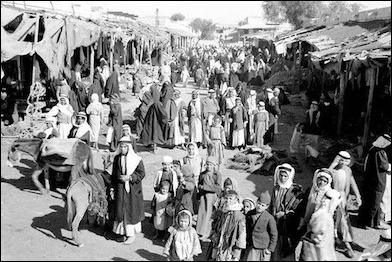
The introduction of European standards of wage and life in Mandate Palestine acted like a magnet on the entire Near East. Abruptly, Palestine began attracting Arabs. By 1922, after a quarter century of Jewish colonization, Arab numbers mushroomed to 488,000. By 1938, the Arab population had reached over a million.
Peters and Avneri describe how the British obstructed Jewish immigration while facilitating or ignoring Arab immigration. Ziff adds details about immigration certificates, labor visas, taxation, and Hadassah aliyahs:
As the "absorptive capacity" of the country increased so tremendously under the stimulus of Jewish investment that any effort to deny it became ludicrous, the government produced still other cards out of its sleeve. It announced in 1936 that 70 percent of the thirteen hundred immigration certificates available for the following six months were ear-marked for bachelors, ten percent for maidens, and 20 percent for men with families, thus cutting down immigration without appearing to do so. Another able device was the refusal to allow the wives and families of employed residents to enter without the precious labor visas though in many cases they were an actual charge on these same residents, who sent money abroad to maintain them.
Such an obvious attempt was made to restrict the entry of women that the Jewish Agency flatly accused the government in November 1934 of a mischievous and willful attempt "directed against any considerable development of the immigration of women into Palestine."
Many of the administration's reasons for refusing entry permits would do credit to Herr Hitler as witness the refusal to grant a visa to a refugee Russian rabbi on the excuse that "there were enough rabbis already in Palestine." Some of the regulations designed to restrict Jewish immigration are classic. One of these edicts, promulgated November 14, 1933, allowed only 250 immigrants "to enter Palestine from any one vessel." Its effectiveness rested on the fact that few of the ships touching Palestine ports could make a payload out of such a small number of travelers, forcing the cancellation of sailings.
Perhaps the outstanding example of official artifice was the schedule announced for the period between October 1, 1935, and March 31, 1936. Four thousand, three hundred and fifty visas were granted ... What was not mentioned were the following deductions made from this schedule in advance: 1,000 certificates "advanced" during the previous six-month period; 250 reserved by the government (for non-Jews); 1,200 taken off to cover "illegal" immigrants who could not be apprehended; and 1,900 for dependents of employed residents (who in any other country would have entered as a matter of course). If these deductions are added up they are found to equal exactly the number of certificates granted; so that the administration was only perpetrating a crude joke on the Zionists and in effect issuing no certificates at all.[16] ...
Everything in this business is made subject to cash. Even the boasted Hadassah aliyahs, by which a few hundred Jewish children were brought in from Germany, were made conditional on a substantial money deposit, much as would be charged if the children had entered a boarding school. The Department of Immigration is a paying business, showing in a typical year a net income of £333,200 against an expenditure of £209,100.[17] ...
Lured by stark evidence of labor scarcity and big pay, peoples from all surrounding states began to drift into Palestine. Though a huge corps of coast and frontier guards kept vigilant watch to prevent the entry of "illegal" Jews, Arabs from anywhere entered without even the gesture of passport investigation. The report of the Peel Commission admits frankly that the inhabitants of Syria and Transjordan "are free to enter the corresponding districts in Palestine without special formality." It is, in fact, by disguising themselves as Arabs that most "illegal" Jewish immigration is accomplished.
A news item of July 4, 1934, gives the circumstance more lucidly than pages of reference. It reads: "Five Jewish women coming overland from Damascus, attired in the traditional costumes of Moslem women, including the black veils, were apprehended at the border when police saw through their disguises. They could not answer questions put to them in Arabic."[18]
Hunting down Jews
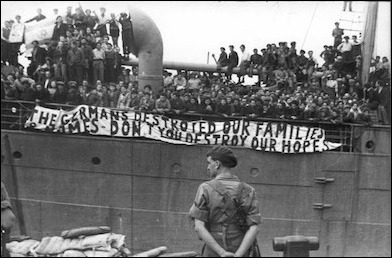
Though guards kept watch to prevent the entry of "illegal" Jews, Arabs from anywhere entered without any passport investigation. The Peel Commission admitted that Arabs from Syria and Transjordan "are free to enter ... Palestine without special formality." Illegal Arab immigrants were also known to work on road and house construction in Petach Tikvah and Haifa
Only Ziff mentions the British practice of hunting down "illegal" Jews:
Coincident with the advent of Hitler, the business assumed the proportions of an out and out Jew-hunt. In a nice piece of collusion between the colonial secretary, Sir Phillip Cunliffe-Lister, and an M.P. named MacDonald, the Government "admitted" that "illegal" Jewish immigration existed but stated in assurance that "practical steps would be taken to deal with the matter." The very next day Cunliffe-Lister announced stringent measures to prevent "illegal" Jewish immigration into Palestine.
The system of tourist deposits was instituted. Holders of Nansen [League of Nations] passports, that pitiful army of staatenlos [stateless] men, were not in future to be granted even tourist visas. An air-tight frontier control in collaboration with the agreeable French authorities in Syria was to be put in effect. On the subject of illegal Arab immigration, the announcement was expressively silent.
Showing the extent of its preorganization, the campaign at once assumed the proportions of a large-scale pursuit of Jews over the length and breadth of Palestine. Ironically paid for out of Jewish tax moneys, a dragnet of airplane and motor boat patrols were detailed along the borders while British and Arab constables, assisted by organized groups of fellaheen, enjoyed themselves in scouring the coast-wise territory.
At Beirut and other Syrian cities, British and Arab police questioned motorbus drivers, asking if Jews were among the passengers, carefully examining the passports of all suspected of being Jews while others were as scrupulously ignored.[19]
According to Ziff,
Hunting "illegal" Jews became a major game, with illegal Arab newcomers enlisting gleefully in the chase. Savage Bedouins joined in under promise of a reward for any Jewish man, woman, or child they could catch. Palestine was under a virtual reign of terror. Anyone who could not immediately prove his citizenship, or produce his or her certificate of entry, was tracked down, jailed, and brutally beaten. ...
A fair example is the case of a woman and six small children, who had arrived legally with the proper passport and visa from Turkestan. On the way, her husband had been killed at a railway station. The whole family was arrested on the grounds that the passport provided not for a woman and six children but for a man, a woman and six children. On this pretext the woman and her children were ordered to prison.[20]
Illegal Arab Immigration
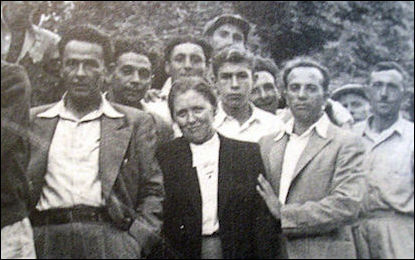
Ziff also writes about futile attempts by Jews to bring the problem of illegal Arab immigrants to the attention of British authorities:
It is, of course, difficult to attain any adequate idea of the extent of this flood of non-Jewish immigration since officially it does not exist. In the absence of accurate canvass, its size must be pieced together and surmised. Such calculations as are available show an Arab immigration for the single year 1933 of at least sixty-four thousand souls. Added to the acknowledged Hauranese infiltration are some two thousand who arrived from Damascus alone. Mokattan, the leading Cairo daily, announced that ten thousand Druses had gone to the Holy Land, and according to al-Jamia al-Islamia, an Arab newspaper of Jaffa, seventeen thousand Egyptians had come from Sinai Peninsula alone.
To these must be added considerable groups of Numidians and even Abyssinians, and a vast uncounted army from Transjordan about whose movement into Palestine not the slightest pretense of legality is maintained.[21]
Ziff adds:
Exasperated by the government's lack of good faith, which was illicitly converting the Holy Land into an Arab country, groups of courageous Jewish youths volunteered in 1934 to point out what apparently the authorities were unable to see. Fourteen hundred of these illegals were quickly shown to be working at Petach Tikvah and 1,200 in Haifa on road and house construction alone. Their probable numbers could be gathered from a test count of 357 Arab laborers in the buildings material industry, which showed 273 to be Hauranis illegally in the country. A check of Arabs employed in Palestine ports on December 23, 1936, showed that only 50 of the 750 workers were Palestinians. The remainder included 200 Egyptians and 500 Hauranis. Whole hordes of these people were demonstrated to be in the employ of the government itself.
Without deigning to make a reply, the administration pointedly told the Jews to mind their own business. When Jews picketed Jewish employers of this alien labor, the government bared its teeth and sentenced the demonstrators to six months at hard labor for their pains. Undeterred, Jews again picketed a Haifa theater being erected by a contractor named Borovsky where illegal Hauranis were employed. Immediately the authorities arrested fifty-three Jews and sentenced them to prison terms.[22]
Population Numbers
Modern authors agree with Ziff that the huge increase in Arab population numbers cannot be accounted for by natural growth. Ziff does the math:
Though the government solemnly estimates in 1937 a total Moslem increase by immigration of only 22,535 since the time of the British occupation, evidence of a vast influx of desert tribesmen is obvious everywhere. As early as 1926, Colonial Secretary Amery cautiously conceded that despite the growth of the Jewish element "the increase of the Arabs is actually greater than the Jews." Figures presented before the Peel Commission in 1937 showed the Arab population to have more than doubled in fourteen years. This admitted gain in half a generation must either be attributed to outside immigration or to the most astonishing philo-progenitiveness in medical history. ...
[T]he government itself acknowledged in 1922 the immigration of whole tribes "from the Hejaz and southern Transjordan into the Beersheba area," a fact which in itself must make its estimates of Arab immigration far-fetched. Other approximate figures are available from scattered but credible sources. One of these is the statement of the French governor of the Hauran in Syria, that from his district alone, in the summer of 1933, thirty-five thousand people had left for Palestine as a consequence of bad crops.[23]
The increase in Arab population due to immigration was no secret. Another important testimony came from Robert Kennedy, the future U.S. attorney general, who traveled at age twenty-two in 1948 to Palestine and reported from there for the Boston Post.. He also noted the influx of Arab immigration into Palestine:
The Jews point with pride to the fact that over 500,000 Arabs in the 12 years between 1932 and 1944 came into Palestine to take advantage of living conditions existing in no other Arab state. This is the only country in the Near and Middle East where an Arab middle class is in existence.[24]
Fred Gottheil summarizes why finding the truth on this topic is important:
[F]or Arab Palestinians, the character of their demography is at the heart of their claim to territorial inheritance and national sovereignty. Their contention, seen by them as being beyond dispute, is that Arab Palestinians have deep and timeless roots in that geography and that their own immigration into that geography has at no time been consequential. To challenge that contention, then, is to challenge their self-selected criterion for sovereignty.[25]
While Ziff's book has lain dormant, his insights regarding the waves of Arab immigration into Palestine substantiates the assertions of later scholars. During the mandate period, Arabs from many lands flowed freely into Palestine while Jewish immigration was severely limited. The truth remains that the native Arab population in Palestine was relatively small before the first Jewish settlers made it an attractive and prosperous place.
Footnotes
[1] Palestine and International Law: The Legal Aspects of the Arab-Israeli Conflict, quoted in Alan Hart, Arafat Terrorist or Peacemaker? (London: Sidgwick and Jackson, 1984), p. 49.
[2] PA TV, Mar. 21, 2016, PMW Bulletin, Palestinian Media Watch, June 6, 2016.
[3] The Times of Israel (Jerusalem), Feb. 12, 2014.
[4] From Time Immemorial: The Origins of the Arab-Jewish Conflict over Palestine (New York: Harper Collins, 1st ed., 1984).
[5] The Claim of Dispossession: Jewish Land-Settlement and the Arabs, 1878-1948 (New Brunswick, N.J.: Transaction Publishers 1982).
[6] Middle East Quarterly, Winter 2003.
[7] Rafael Medoff, Militant Zionism in America: The Rise and Impact of the Jabotinsky Movement in the United States, 1926-1948 (Tuscaloosa: University Alabama Press, 2002), pp. 39-40.
[8] See also, Daniel Pipes, "The 11th-Encyclopaedia Britannica on Who Is a Palestinian," Lion's Den: Daniel Pipes Blog, July 31, 2016.
[9] Ziff, The Rape of Palestine, pp. 368-9. Italics in original.
[10] Ibid., p. 185.
[11] Ibid., pp. 178-9.
[12] Ibid., pp. 385-6.
[13] Ibid., pp. 235-6.
[14] Ibid., p. 135.
[15] Ibid., p. 248.
[16] Ibid., pp. 237-8. Italics in original.
[17] Ibid., pp. 238-9.
[18] Ibid., pp. 246-7. Italics in original.
[19] Ibid., pp. 243-4.
[20] Ibid., pp. 245-6. Italics in original.
[21] Ibid., p. 248.
[22] Ibid., p. 249.
[23] Ibid., p. 247.
[24] Robert Kennedy, "British Hated Both Sides," The BostonPost, June 3, 1948, http://robertkennedyandisrael.blogspot.com/.
[25] Fred M. Gottheil, "The Smoking Gun: Arab Immigration into Palestine, 1922-1931," Middle East Quarterly, Winter 2003, pp. 53-64.
Sheree Roth writes about the Israel-Arab conflict from Palo Alto, California.
This article appeared as the Fall 2016 issue of the Middle East
Quarterly in Volume 23, as Number 4; it is archived at
http://www.meforum.org/6275/were-the-arabs-indigenous-to-mandatory-palestine